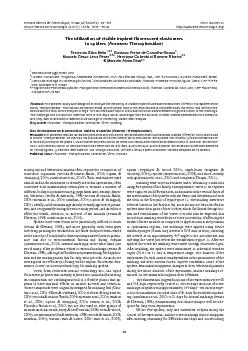

The utilization of visible implant fluorescent elastomers in spiders Araneae Theraphosidae Tercio da Silva Melo Gustavo Freire de CarvalhoSouza Marcelo Cesar Lima Peresi Browne Ribeiro Marcelo ID: 828142
Download Pdf The PPT/PDF document "n" is the property of its rightful owner. Permission is granted to download and print the materials on this web site for personal, non-commercial use only, and to display it on your personal computer provided you do not modify the materials and that you retain all copyright notices contained in the materials. By downloading content from our website, you accept the terms of this agreement.
nº (31/12/2013): 99101.
nº (31/12/2013): 99101. NOTA CIENTÍFICAGrupo Ibérico de Aracnología (S.E.A.). ISSN: 1576 - 9518. http://www.sea-entomologia.org/ The utilization of visible implant fluorescent elastomers in spiders (Araneae: Theraphosidae) Tercio da Silva Melo, Gustavo Freire de Carvalho-SouzaMarcelo Cesar Lima Peresi Browne Ribeiro& Marcelo Alves Dias Programa de Pós-Graduação em Planejamento Territorial e Desenvolvimento Social, Avenida Cardeal da Silva, 205, CEP 40231-902, Abstract: The present study was designed to analyze the efficiency of visible implant fluorescent elastomers (VIFE) in five spiders of tfamily Theraphosidae. The individuals were ma spiders. * Immatures spiders. Marking date Molting date Loss of marking Date of death sp.* 13/04/10 None No 27/07/10 105 days sp. 13/04/10 None No 06/10/10 176 days sp.* 29/04/10 None No 27/07/10 89 days Aviculariinae sp. 29/04/10 None No 28/06/10 60 days sp.* 04/06/10 01/07/10 No 15/04/11 316 days the findings of Chapin (2011). The conservation of the markings (even after ecdysis), associated with their long duration, will allow studies focusing on the spider ecology and development to be under-taken in the natural environment with greater data fidelity (Melo ., 2010; Chapin, 2011) as their tags will not be lost.The advantages of VIFE as a new marking technique for spiders resides in its long duration time as well as its permanence after ecdysis. As there are many colors available with VIFE, and spiders have large numbers of articulations available for marking, large numbers of unique combi-nations of colors and marking localities can be created, thus permit-ting the identification of many individual animals. In spite of the necessity of handling the animal, VIFE marking is simple enough to be applied rapidly and securely even in the uncontrolled conditions encountered in field environments. The principal limiting factor of this technique is the size of the animal. We believe the mi
nimum size for this marking application
nimum size for this marking application are ani-Our results indicate that VIFE is equal to or more adequate than external or internal marking techniques previously described in the literature, although it will still be necessary to undertake addi-tional experiments with more spiders to ratify the advantages and efficiency of this technique, and confirm marking durations under AcknowledgmentsThe authors would like to thank the laboratory assistants responsible for maintaining spiders at the Centro Lacerta Consultoria, Projetos & Assessoria Ambiental LTDA for making VIFE available for application in these animals; the Universidade Católica do Salvador for the support extended to M.C.L. Peres. 2007. Use of coded-wire and visible implant elastomer tags for marine stock enhancement with juvenile red snapper Lutjanus campechanus90-97. 2007. Evaluation of Visible Implant Elastomer for Marking Juvenile Red Drum. North American Journal of Fisheries Management, : 460-464. OWE 2009. Is tagging with visual implant elastomer a reliable technique for marking earthworms? Pesquisa Agropecuária Brasileira: 969-974. OWE 2007. A viable technique for tagging earthworms using visible implant elastomer. Applied Soil Ecology,: 454-457. ROWNE 2010. Avaliação do Implante Visível de Elastómero Fluorescente (VIFE) em Tricogaster trichopterus (Pallas, 1770) em cativeiro, incluindo informações sobre a técnica utilizada. Revista Brasileira de Biociências,: 24-29. 2001. Evalu-ation of Injectable Fluorescent Tags for Marking Centrarchid Fishes: Retention Rate and Effects on Vulnerability to Predation. ican Journal of Fisheries Management,: 911-917. , J.K. 2011. Suitability of a subcuticular permanent marking technique for scorpions. The Journal of Arachnology,: 194-196. 1998. A new method of marking spiders. Journal of Arachnology,: 382-384. 2006. Effects of subcutaneous fluorescent tags on the growth and survival of a newly settled coral reef fish, (Pomacentridae). Proceedinas of 10th In-ternational Coral Reef Symposium, 420-424. ATTHEWSOODWARD 2008. Visible Implant Fluorescent Elastomer: A Reliable Marking Alternative for Snakes. :
301-303. 2008. Visible implant elastom
301-303. 2008. Visible implant elastomer (VIE) marking of brown trout, , alevins. Fishe-ries Management and Ecology,: 81-83. 2007. Evaluation of a simple tagging method to monitor the growth of endangered species of seahorse. : 1631-1632. , Y. 2007. Influence of Visible Implant Fluorescent Elastomer (VIE) Tagging on Growth, Molting and Survival of the Eastern White River Crayfish, Procambarus acutus acutus (Girard, 1852). nal of Zoology,: 209-212. ROWNE 2010. ¿Una nueva técnica para El marcación de arañas?. Libro de resumos do I Congreso Uruguayo de Zoología, p.224. 2001. An Evaluation of Visible Implant Elastomer for Marking Age-0 Brown Trout. North American Journal of Fisheries Management,: 967-970. 2005. Marking Salamander Egg Masses with Visible Fluorescent Elastomer: Retention Time and Effect on Embryonic Development. The American Midland Naturalist,60. 2007. A preliminary investigation of the use of subcutaneous tagging in Caribbean reef squid (Cephalopoda: Loliginidae). 313. 2004. A Comparison of Injectable Fluo-rescent Marks in Two Genera of Darters: Effects on Survival and Re-North American Journal of Fisheries Management,1017-1024. 1998. Retention and in situ detectability of visible implant fluorescent elastomer (VIFE) tags in Pagrus auratus (Sparidae). New Zealand Journal of Marine and Freshwater Re-: 247-254. 2004. Visible implant fluorescent elastomer tagging of the big-bellied seahorse, : 363-371. 2003. Evaluation of visible implant fluores-cent elastomer (VIE) as a tagging technique for spiny lobster (Marine and Freshwater Research, : 853-858. 2010. An alternative technique for individual marking of orb-web spiders. Revista de Etologia,: 3-5. 2009. Impact of visible implant elastomer tags on the growth rate of captive Caribbean reef squid Sepioteuthis sepioidea: 362-364. 1a1b1c1d101Fig.1.PhotographsdemonstratingtheapplicationofVIFEmarkings.–TheapplicationprocessofVIFEunderultravioletlight.–Amplifiedimageofthemarkingapplication.–Visualizationofthemarkingundervisiblelight.–Visualizationofthemarkingunderultravioletlight.Arrow–Indicationofthemarkinglocality